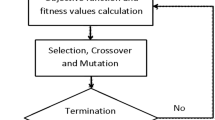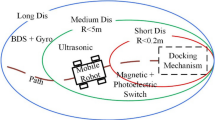Abstract
When a robot goes from the initial position to the goal position in an unknown environment, we need the autonomous navigation for avoiding the obstacles and moving toward the goal position simultaneously. Among the various methods, we focus on the navigation method by using the geometric analysis with a laser scanner having the high resolution. When the robot turns around the obstacle, our proposed navigation method supplies the robot with the turning point for avoiding the obstacle and moving on the shortest path. At the same time, the next heading velocity is generated for the robot to have the maximum velocity by using the distance between the current position of the robot and the turning point. The robot executes the navigation in the unknown workspace which the various obstacles are randomly located. As the experimental results, we obtain the shortest path of the robot regardless of the obstacle’s shape in the unknown environment.
Similar content being viewed by others
References
Borenstein J, Koren Y (1988) Obstacle avoidance with ultrasonic sensors. IEEE J Robot Autom 4(2):213–218. doi:10.1109/56.2085
Borenstein J, Borenstein J, Koren Y (1991) The vector field histogram-fast obstacle avoidance for mobile robots. IEEE Trans Robot Autom 7(3):278–288. doi:10.1109/70.88137
Dubins LE (1957) On curves of minimal length with a constraints on average curvature. Am J Math 79:497–516
Fox D, Burgard W, Thrun S (1997) The dynamic window approach to collision avoidance. IEEE Robot Autom Mag 4(1):23–33. doi:10.1109/100.580977
Ibrahim M, McFetridge L (2001) The agoraphilic algorithm: a new optimistic approach for mobile robot navigation. In: Proc IEEE/ASME international conference on advanced intelligent mechatronics, vol 2, pp 1334–1339, vol 2. doi:10.1109/AIM.2001.936923
Ibrahim M, Ibrahim M, Fernandes A (2004) Study on mobile robot navigation techniques. In: Fernandes A (ed) Proc IEEE international conference on industrial technology IEEE ICIT ’04, vol 1, pp 230–236, vol 1. doi:10.1109/ICIT.2004.1490288
Koren Y, Borenstein J (1991) Potential field methods and their inherent limitations for mobile robot navigation. In: Proc IEEE international conference on robotics and automation, pp 1398–1404. doi:10.1109/ROBOT.1991.131810
Kruusmaa M (2003) Global level path planning for mobile robots in dynamic environments. J Intell Robotics Syst 38(1):55–83. doi:10.1023/A:1026296011183
Li Y, He K (2005) A novel obstacle avoidance and navigation method of outdoor mobile robot. In: Proc th international conference on advanced robotics ICAR ’05, pp 653–656. doi:10.1109/ICAR.2005.1507478
Minguez J, Montano L (2000) Nearness diagram navigation (nd): a new real time collision avoidance approach. In: Proc IEEE/RSJ international conference on intelligent robots and systems (IROS 2000), vol 3, pp 2094–2100. doi:10.1109/IROS.2000.895280
Minguez J, Montano L (2009) Extending collision avoidance methods to consider the vehicle shape, kinematics, and dynamics of a mobile robot. IEEE Trans Robot 25(2):367–381. doi:10.1109/TRO.2009.2011526
Minguez J, Montano L, Simeon T, Alami R (2001) Global nearness diagram navigation (gnd). In: Proc ICRA robotics and automation IEEE international conference on, vol 1, pp 33–39. doi:10.1109/ROBOT.2001.932526
Minguez J, Montano L, Santos-Victor J (2002) Reactive navigation for non-holonomic robots using the ego-kinematic space. In: Proc IEEE international conference on robotics and automation ICRA ’02, vol 3, pp 3074–3080. doi:10.1109/ROBOT.2002.1013699
Seki H, Shibayama S, Kamiya Y, Hikizu M (2008) Practical obstacle avoidance using potential field for a nonholonmic mobile robot with rectangular body. In: Proc IEEE international conference on emerging technologies and factory automation ETFA 2008, pp 326–332. doi:10.1109/ETFA.2008.4638414
Ulrich I, Borenstein J (2000) Vfh local obstacle avoidance with look-ahead verification. In: Proc IEEE international conference on robotics and automation ICRA ’00, vol 3, pp 2505–2511. doi:10.1109/ROBOT.2000.846405
Yang X, Patel RV, Moallem M (2006) A fuzzy–braitenberg navigation strategy for differential drive mobile robots. J Intell Robotics Syst 47(2):101–124. doi:10.1007/s10846-006-9055-3
You B, Qiu J, Li D (2008) A novel obstacle avoidance method for low-cost household mobile robot. In: Proc IEEE international conference on automation and logistics ICAL 2008, pp 111–116. doi:10.1109/ICAL.2008.4636130
Zhang L, Ghosh BK (2000) Line segment based map building and localization using 2d laser rangefinder. In: Proc IEEE international conference on robotics and automation ICRA ’00, vol 3, pp 2538–2543. doi:10.1109/ROBOT.2000.846410
Author information
Authors and Affiliations
Corresponding author
Rights and permissions
About this article
Cite this article
Hong, J., Park, K. A new mobile robot navigation using a turning point searching algorithm with the consideration of obstacle avoidance. Int J Adv Manuf Technol 52, 763–775 (2011). https://doi.org/10.1007/s00170-010-2749-5
Received:
Accepted:
Published:
Issue Date:
DOI: https://doi.org/10.1007/s00170-010-2749-5




